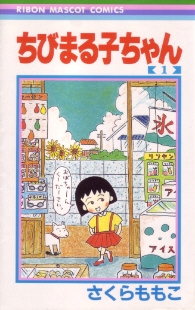
Back ماروكو الصغيرة Arabic Chibi Maruko Chan German Chibi Maruko-chan Spanish Chibi Maruko-chan French Yin-thò Séu-yên-chṳ́ HAK Chibi Maruko-chan ID Chibi Maruko-chan Italian ちびまる子ちゃん Japanese Chibi Maruko-chan JV 마루코는 아홉살 Korean
| Chibi Maruko-chan | |
 Cover of the first tankōbon volume, featuring Momoko Sakura (Maruko) | |
| ちびまる子ちゃん | |
|---|---|
| Genre | Slice of life |
| Manga | |
| Written by | Momoko Sakura |
| Published by | Shueisha |
| Imprint | Ribon Mascot Comics |
| Magazine | Ribon |
| Demographic | Shōjo |
| Original run | August 1986 – October 2022 |
| Volumes | 18 |
| Anime television series | |
| Directed by | Yumiko Suda Tsutomu Shibayama |
| Music by | Nobuyuki Nakamura |
| Studio | Nippon Animation |
| Original network | FNS (Fuji TV) |
| English network | |
| Original run | January 7, 1990 – September 27, 1992 |
| Episodes | 142 |
| Anime film | |
| Directed by | Yumiko Suda Tsutomu Shibayama |
| Written by | Momoko Sakura |
| Music by | Nobuyuki Nakamura |
| Studio | Nippon Animation |
| Released | December 15, 1990 |
| Runtime | 94 minutes |
| Anime film | |
| Chibi Maruko-chan: My Favorite Song | |
| Directed by | Yumiko Suda Tsutomu Shibayama |
| Written by | Momoko Sakura |
| Studio | Nippon Animation |
| Released | December 19, 1992 |
| Runtime | 93 minutes |
| Anime television series | |
| Directed by | Jun Takagi |
| Music by | Nobuyuki Nakamura |
| Studio | Nippon Animation |
| Licensed by | |
| Original network | FNS (Fuji TV) |
| English network | |
| Original run | January 8, 1995 – present |
| Episodes | 1437 |
| Television drama | |
| Chibi Maruko-chan (live-action special) | |
| Original network | FNS (Fuji TV) |
| Original run | April 18, 2006 – October 31, 2006 |
| Episodes | 2 |
| Television drama | |
| Marumaru Maruko-chan | |
| Original network | FNS (Fuji TV) |
| Original run | April 19, 2007 – February 28, 2008 |
| Episodes | 31 |
| Anime film | |
Chibi Maruko-chan (Japanese: ちびまる子ちゃん, lit. "Little Maruko-chan") is a manga series written and illustrated by Momoko Sakura. The series depicts the simple, everyday life of Momoko Sakura, a young girl everyone calls Maruko, and her family in suburban Japan in the year 1974. Maruko is a troublemaker, and every episode recounts Maruko's trouble and how she and her friends succeed in solving the situation. The series is set in the former of Irie District (入江町), Shimizu, now part of Shizuoka City, birthplace of its author.
The first story under the title "Chibi Maruko-chan" was published in the August 1986 edition of the manga magazine Ribon. Other semi-autobiographical stories by the author had appeared in Ribon and Ribon Original in 1984 and 1985, and were included in the first "Chibi Maruko-chan" tankōbon in 1987. The author first began writing and submitting strips in her final year of senior high school, although Shueisha (the publisher of Ribon and Ribon Original) did not decide to run them until over a year later. The author's intent was to write "essays in manga form";[1] many stories are inspired by incidents from her own life, and some characters are based on her family and friends. The nostalgic, honest and thoughtful tone of the strip led to its becoming popular among a wider audience.
Chibi Maruko-chan was adapted into an anime television series by Nippon Animation, which originally aired on Fuji Television and affiliated TV stations from January 7, 1990, to September 27, 1992. It has also spawned numerous games, animated films and merchandising, as well as a second TV series running from 1995 to the present. Maruko's style and themes are sometimes compared to the classic comic Sazae-san. In 1989, the manga tied to receive the Kodansha Manga Award for the shōjo category.[2] As of 2006, the collected volumes of the manga had sold more than 31 million copies in Japan, making it one of the best-selling manga series.[3]
On April 25, 2020, it was announced that the second series would be suspended due to the COVID-19 pandemic.[4] On June 14, 2020, it was announced that it would resume on June 21, 2020.[5]
- ^ "夢の音色" Chibi Maruko-chan, January 18, 1989, volume 4, page 135.
- ^ Hahn, Joel. "Kodansha Manga Awards". Comic Book Awards Almanac. Retrieved May 25, 2009.
- ^ "Historic Shōjo Manga Circulation Numbers". ComiPress. May 24, 2006. Archived from the original on February 6, 2012. Retrieved January 6, 2008.
- ^ "Maruko-chan Anime Delays New Episodes Due to COVID-19". July 10, 2023.
- ^ "Chibi Maruko-chan Anime Resumes New Episodes After COVID-19 Delay". July 10, 2023.